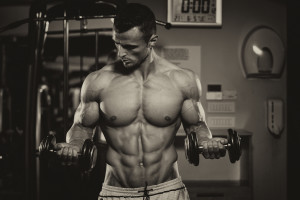Cardio vs Weights: Introduction
Once upon a time, after World War II, the U.S. and Russia each became obsessed with two very different forms of exercise:
Russia became obsessed with strength-training, kettlebells, and weight-lifting.
And here in the U.S., we became obsessed with cardiovascular exercise and aerobic fitness.
Now I’m not going to say one of these forms of exercise is better than the other. They’re different. After all, if your goal is to run a marathon, you should do cardio. If your goal is to squat 400 pounds, you should lift weights.
But what if your goal is to improve your appearance and become the most attractive version of yourself? Then what should you do, cardio or weights?
Read on to discover the answer.
Cardio vs Weights, Round 1: Calories Burned
When it comes to weight loss, burning more calories is a big part of the equation. So this is the first quality we’re going to judge.
How Many Calories Does Cardio Burn?
Most people naturally think of cardio when they want to burn calories, but the truth is that cardio burns way less calories than you think.
Even if you’re using a cardio machine, like an elliptical, and it tells you that you burned x calories…it’s probably wrong and/or misleading.
As Pat Koch describes very well in this article, cardio machines usually overestimate how many calories you burn during a session. The 2 main reasons:
- These machines take your resting metabolic rate (RMR) into account.
In other words, the elliptical machine might claim that you burnt 300 calories during your workout…but 120 of those calories might come from your RMR (calories your body uses to keep your heart beating, lungs working, etc.). So while you DID burn 300 calories, you only burned 180 EXTRA calories from the exercise itself. - These machines don’t take into account exercise efficiency.
The more you perform a certain exercise, the more efficient your body becomes at that exercise. When you go out running for the first time ever, you may burn 500 calories in 30 minutes. Go running 4 times a week for a year straight, and that same workout will burn only 300 calories. It’s your body’s way of conserving energy.
Does Weight Training Really Increase Your Metabolism?
Most people think of weight training as muscle building, not fat loss. The truth is, it’s both. Not only does weight training burn calories while you’re doing it, it also raises your metabolism via the “afterburn effect.”
But how much does weight lifting really increase your metabolism?
Some people claim that your body burns an extra 50 calories for every pound of muscle you add. That’s bullshit. The truth is that your body burns about 6 extra calories for every pound of muscle. So yes, it does raise your metabolism…but not by much.
So Who Wins Round 1?

So far there’s no clear winner. But here’s the thing: we’re talking about fat loss. Not just weight loss. FAT loss.
And that means losing weight AND maintaining your muscle.
Cardio may help you lose more weight, but if all you do is cardio then you’ll lose more muscle.
Weight lifting won’t help you lose as much total weight, but more of that weight will be from fat.
That makes weight lifting the superior exercise if your goal is to lose fat, build or maintain muscle, and improve your overall body composition and sex appeal.
Winner: Weights. Because of their ability to help you lose fat and not muscle.
Cardio vs Weights, Round 2: Convenience
Who cares which exercise is more effective if you don’t actually do it?
That’s why convenience is so important. Convenience is vastly underrated in my experience, because if you try to start a workout program that isn’t convenient, you’re less likely to actually stick to it.
Weight Training Requires Equipment
Yeah, you can do some body-weight moves…but to really progress in strength training, you should ideally have access to a gym. You can set up a home gym, too, but that requires a lot of space and up-front money.
The convenience of going to a gym can vary wildly. You might have an awesome gym right down the street that’s $10/month…or your best option might be 35 minutes away where it’s $100/month and packed to the gills.

You Can Do Cardio Anywhere
The convenience factor is where cardio really shines. You don’t need anything to get in a great cardio workout; all you need is a room and you can get in a kick-butt interval workout using burpees and jump-squats.
Add a pair of shoes and you can run, sprint, jump, walk, and do all sorts of exercises outside (which can be really pleasant on a nice day).
Winner: Cardio. In a landslide.
Cardio vs Weights, Round 3: Health Benefits
Which is actually better for your body?
The Health Benefits of Weight Lifting
Weight lifting makes you big and strong, improves insulin sensitivity, and prevents muscle wasting as you age. As long as you exercise good form, weight lifting will also help prevent injuries to areas like your back and your knees.
There are downsides to weight lifting, of course. If you don’t use good form, you could injure yourself (people die every year from dropping the bar on their neck during bench press).
The Health Benefits of Cardio
Cardio generates great muscular endurance and athleticism. It also improves your oxygen delivery and is excellent for your heart and lungs.
The downside here is that too much running on hard surfaces can be hard on your joints and really wear you down over time.
Winner: Tie. They both have outstanding health benefits that are totally different. How can you choose?
And The Winner Is…

Nutrition!
That’s right, folks. It’s a dramatic turn of events, but the real king of weight loss isn’t cardio…it isn’t weight lifting…it’s eating smart.
Yes, exercise is important. But if your goal is to lose weight, you MUST get your diet dialed in first. That’s the #1 most important thing, bar none.
You can lift all the weights and do all the cardio you want…but if you eat like a fatass, you’ll still be a fatass. A fatass with strong muscles and good muscular endurance, but a fatass nonetheless.
Seriously, What Should You Do?
Ok, so as I said, nutrition is priority #1. You have to get your diet dialed in so you’re eating at a slight calorie deficit, or you’re never going to lose weight.
After that, what should you do? Start with weight training. The combination of diet + weights is an insanely effective one, and you can use it to get very, very lean if you want to. Cardio really isn’t necessary, although I highly recommend staying physically active (take walks, go hiking, play a sport, etc.).
If you want to get really lean, however, then you’re probably going to need some cardio. I’ve never been able to get super cut without some cardio. This helps burn a few extra calories which gives me a little more leeway in my diet.
So there you have it, guys:
If your goal is body recomposition, first dial in your nutrition and start a solid strength-training workout. Then, add in some cardio when you want to reach more elite levels of Stronger+Leaner status. (Say under 10% bodyfat.)
Want A Program That Follows These Exact Guidelines?
Check out my top-tier training program, The Stronger+Leaner Guide to Getting Ripped.
This program will teach you how to shed fat and build lean muscle using a smart combination of diet and weight-lifting.
It’s the most effective protocol I know for getting a shredded, chiseled, RIPPED physique.